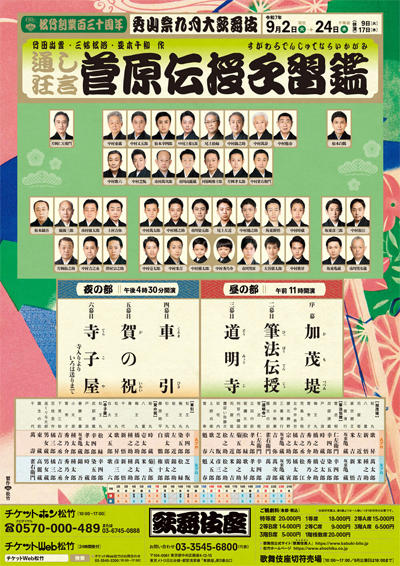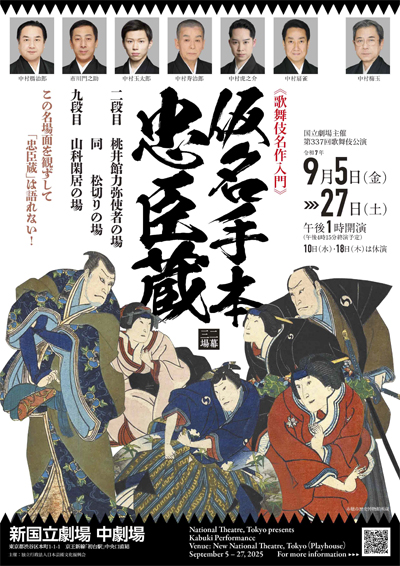| Casting |
Living National Treasure Kataoka Nizaemon, Living National Treasure Nakamura T˘z˘, Living National Treasure Nakamura Karoku, Matsumoto Haku˘, Nakamura Kaishun, Nakamura Manju, Nakamura Shikan, Onoe Kikugor˘, Matsumoto K˘shir˘, Nakamura Jakuemon, Kataoka Takatar˘, Nakamura Kinnosuke, Onoe Sh˘roku, Nakamura Matagor˘, Band˘ Hikosabur˘, Ichikawa Omez˘, Band˘ Kamez˘, Nakamura Kazutar˘, Nakamura Tokiz˘, Nakamura Yonekichi,
Nakamura Matsue, Kamimura Kichiya, Ichimura Manjir˘, Ichikawa Komaz˘, Matsumoto Kingo, Sawamura S˘nosuke, Band˘ Shingo, Nakamura Kash˘, Nakamura Hashinosuke, Nakamura Mantar˘, Nakamura Tanenosuke, ďtani Hirotar˘, Ichikawa Somegor˘, Onoe Sakon, Ichikawa Otora, Nakamura Kichinoj˘, Arashi Kitsusabur˘, Ichimura Kitsutar˘, Kataoka Matsunosuke, Nakamura Tanetar˘, Nakamura Hidenosuke
|
| Comments |
The 4th edition at the Kabukiza of the new "Shűzan Matsuri" (the festival of Shűzan), which is staged to commemorate late Nakamura Kichiemon II. Shűzan was the haimy˘ used by both Nakamura Kichiemon I and Nakamura Kichiemon II.
There 2 different castings with 2 programs entitled A & B. Below, we've listed actors with a (Prog A/Prog B) format. If there is only one name, it means that the same actor performs the role in both programs.
Sugawara Denju Tenarai Kagami:
(Sugawara and the Secrets of Calligraphy)
Sugawara no Michizane (known in this play as Kan Sh˘j˘) was a high-ranking imperial court
minister who was a brilliant calligrapher and scholar. But political rivalries forced him to
be exiled to distant Kyűshű, where he died. After Michizane's death, a series of disasters
in the imperial capital were attributed to his angry spirit and he was appeased by being
made a god known as Tenjin, and he is now revered as the god of learning. His story was
dramatized as an epic puppet drama in 1746 and the play remains a favorite in both Kabuki
and the Bunraku puppet theatre.
Kamo Zutsumi:
(The Kamo Riverbank)
Young Sakuramaru (Nakamura Kash˘/Nakamura Mantar˘) serves imperial prince Tokiyo (Nakamura Yonekichi/Band˘ Shingo) who has fallen in
love with Princess Kariya (Onoe Sakon/Nakamura Yonekichi), Michizane's beautiful daughter.
Sakuramaru and his wife Yae (Band˘ Shingo/Nakamura Tanenosuke) are charmed by the affair, since
it reminds them of their own love. But the affair is discovered and Michizane's
rivals use it as proof that he is attempting to take over the imperial court.
This innocent love affair triggers the tragedies of the play. Featuring also Band˘ Kamez˘ as Miyoshi Kiyotsura.
Hipp˘ Denju:
(Calligraphy Instruction)
Michizane, in this play called Kan Sh˘j˘ (Living National Treasure Kataoka Nizaemon/Matsumoto K˘shir˘), after his title,
knows that he will soon be exiled. Before he goes, he hands over the scroll of his
secrets to his most talented student Genz˘ (Matsumoto K˘shir˘/Ichikawa Somegor˘). But Genz˘ was disowned forever for
having an affair with Tonami (Nakamura Tokiz˘/Nakamura Kazutar˘), another servant in the household. Only the intervention
of Kan Sh˘j˘ĺs wife Sonoo-no-Mae (Nakamura Jakuemon/Nakamura Manju) saved their lives. Even though Genz˘ receives his
masterĺs teachings, he is not forgiven. Sugawara is arrested, but as Genz˘ and his
wife leave, they rescue Kan Sh˘j˘ĺs young son and take him to safety.
D˘my˘ji:
(At the D˘my˘ji Temple)
On his way to exile, Kan Sh˘j˘ (Living National Treasure Kataoka Nizaemon/Matsumoto K˘shir˘) is allowed to stop at the home of his aunt,
Kakuju (Nakamura Kaishun). There he carves a statue of himself for his aunt.
But Princess Kariya (Onoe Sakon/Nakamura Yonekichi) is actually Kakuju's daughter and was
adopted by Kan Sh˘j˘. She has come desperately hoping to say farewell
to him, but she is punished severely by Kakuju for having been responsible
for Kan Sh˘j˘'s downfall. At the same time, Kakuju has another daughter,
Tatsuta (Kataoka Takatar˘) and Tatsuta's husband Sukune Tar˘ (Onoe Sh˘roku/Nakamura Kash˘) and
father-in-law (Living National Treasure Nakamura Karoku/Nakamura Matagor˘) are plotting to assassinate Kan Sh˘j˘ by
pretending to be the emissary to take him to exile and then killing him.
But miraculously, the statue Kan Sh˘j˘ carved comes to life and saves
his life. Finally, when the real emissary Terukuni (Onoe Kikugor˘/Nakamura Kinnosuke) appears,
Kan Sh˘j˘ must part from his family as he goes into exile.
Featuring also Nakamura Shikan/Band˘ Hikosabur˘ as the yakko Takunai.
Kurumabiki:
(The Tug-of-War Over the Carriage)
There are three brothers serving three masters. Ume˘maru serves Kan Sh˘j˘.
Sakuramaru serves imperial prince Tokiyo. Kan Sh˘j˘ has been sent into exile and Tokiyo
is in disgrace. Ume˘maru (Ichikawa Somegor˘/Onoe Sh˘roku) and Sakuramaru (Onoe Sakon/Nakamura Kinnosuke) lament the disaster that has overtaken their masters.
But they hear that the carriage of Fujiwara no Shihei (Matsumoto Haku˘/Kawarasaki Gonjűr˘) is coming. Shihei is the villain
that has sent Kan Sh˘j˘ into exile. But when the two brothers confront the carriage,
they are stopped by their brother Matsu˘maru (Matsumoto K˘shir˘/Nakamura Shikan), who serves Shihei.
Nonetheless, they attack the carriage and are driven back by the magical powers of Shihei.
The three brothers agree to meet again at the seventieth birthday of their father, Shiratayű.
Ga no Iwai:
(The Birthday Celebration)
Shiratayű has long served Kan Sh˘j˘ and when he had three sons, he named them after
the favorite trees in his garden, the pine (matsu),
the plum (ume) and the cherry (sakura)
and had them all take service with important court nobles. However, the three lords of his
sons have all been torn to separate sides. Today is Shiratayű's birthday and all three sons
are to come. Chiyo (Band˘ Shingo), Matsu˘maru's wife, Haru (Nakamura Tanenosuke), Ume˘maru's wife, and Yae (Nakamura Kazutar˘/Nakamura Yonekichi), Sakuramaru's wife,
all prepare festive food for the happy event. Since the brothers haven't arrived yet, Shiratayű (Nakamura Matagor˘/Living National Treasure Nakamura Karoku)
goes away with Yae to a shrine to pray. Matsu˘maru (Nakamura Kash˘/Band˘ Hikosabur˘) and Ume˘maru (Nakamura Hashinosuke/Nakamura Mantar˘) appear and immediately start
wrestling with each other, almost like mischievous children. They accidentally break the
branches of the cherry tree, an omen prefiguring the tragic conclusion of this act.
Sakuramaru (Nakamura Tokiz˘/Onoe Kikugor˘) commits ritual suicide to atone for being responsible for Kan Sh˘j˘'s exile.
Terakoya:
(The Village School)
Genz˘ (Matsumoto K˘shir˘/Ichikawa Somegor˘) and his wife Tonami (Kataoka Takatar˘/Nakamura Tokiz˘) run a small school and are protecting Kan Sh˘j˘'s son
and heir, saying that he is their son. However, word has gotten out Kan Sh˘j˘'s son is
there and Genz˘ has been ordered to behead him. Moreover, Matsu˘maru (Onoe Sh˘roku/Matsumoto K˘shir˘) is to come to inspect
the head. Their only alternative is to kill one of the other students as a substitute,
but all of the students are farmer's children who could never pass for the son of a
court aristocrat. However, a new boy arrives that day and Genz˘ makes the terrible decision
to kill him in the place of his lord. As it turns out, Matsu˘maru has sent his own son to
be sacrificed, because of his family's long loyalty to Kan Sh˘j˘. But he must face the most
terrible situation for a father, inspecting the head of his own son and lying when he
says that it is the genuine head of the son of Kan Sh˘j˘.
Finally Matsu˘maru reveals his true feelings to Genz˘ and he and his wife Chiyo (Nakamura Manju/Nakamura Jakuemon) mourn their
dead son.
Sources: Earphone Guide Website or Sh˘chiku Kabuki Official Website
|









